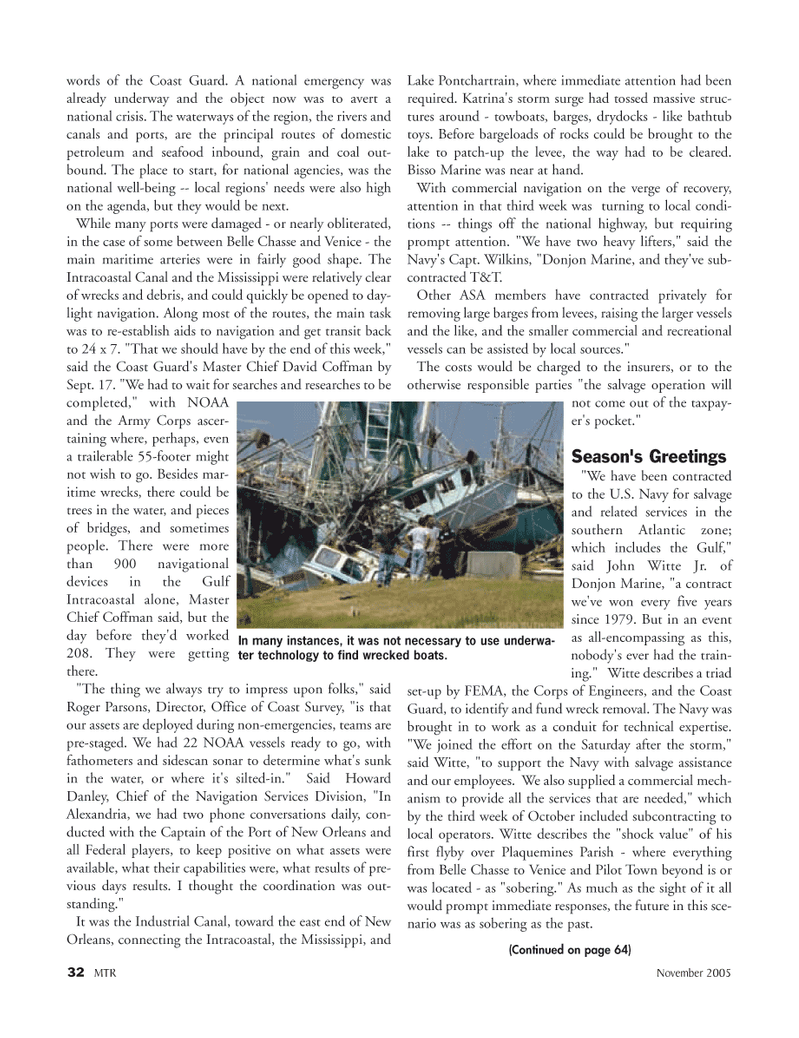
Page 32: of Marine Technology Magazine (November 2005)
Seafloor Engineering
Read this page in Pdf, Flash or Html5 edition of November 2005 Marine Technology Magazine
32 MTR November 2005 words of the Coast Guard. A national emergency was already underway and the object now was to avert a national crisis. The waterways of the region, the rivers and canals and ports, are the principal routes of domestic petroleum and seafood inbound, grain and coal out- bound. The place to start, for national agencies, was the national well-being -- local regions' needs were also high on the agenda, but they would be next.
While many ports were damaged - or nearly obliterated, in the case of some between Belle Chasse and Venice - the main maritime arteries were in fairly good shape. The
Intracoastal Canal and the Mississippi were relatively clear of wrecks and debris, and could quickly be opened to day- light navigation. Along most of the routes, the main task was to re-establish aids to navigation and get transit back to 24 x 7. "That we should have by the end of this week," said the Coast Guard's Master Chief David Coffman by
Sept. 17. "We had to wait for searches and researches to be completed," with NOAA and the Army Corps ascer- taining where, perhaps, even a trailerable 55-footer might not wish to go. Besides mar- itime wrecks, there could be trees in the water, and pieces of bridges, and sometimes people. There were more than 900 navigational devices in the Gulf
Intracoastal alone, Master
Chief Coffman said, but the day before they'd worked 208. They were getting there. "The thing we always try to impress upon folks," said
Roger Parsons, Director, Office of Coast Survey, "is that our assets are deployed during non-emergencies, teams are pre-staged. We had 22 NOAA vessels ready to go, with fathometers and sidescan sonar to determine what's sunk in the water, or where it's silted-in." Said Howard
Danley, Chief of the Navigation Services Division, "In
Alexandria, we had two phone conversations daily, con- ducted with the Captain of the Port of New Orleans and all Federal players, to keep positive on what assets were available, what their capabilities were, what results of pre- vious days results. I thought the coordination was out- standing."
It was the Industrial Canal, toward the east end of New
Orleans, connecting the Intracoastal, the Mississippi, and
Lake Pontchartrain, where immediate attention had been required. Katrina's storm surge had tossed massive struc- tures around - towboats, barges, drydocks - like bathtub toys. Before bargeloads of rocks could be brought to the lake to patch-up the levee, the way had to be cleared.
Bisso Marine was near at hand.
With commercial navigation on the verge of recovery, attention in that third week was turning to local condi- tions -- things off the national highway, but requiring prompt attention. "We have two heavy lifters," said the
Navy's Capt. Wilkins, "Donjon Marine, and they've sub- contracted T&T.
Other ASA members have contracted privately for removing large barges from levees, raising the larger vessels and the like, and the smaller commercial and recreational vessels can be assisted by local sources."
The costs would be charged to the insurers, or to the otherwise responsible parties "the salvage operation will not come out of the taxpay- er's pocket."
Season's Greetings "We have been contracted to the U.S. Navy for salvage and related services in the southern Atlantic zone; which includes the Gulf," said John Witte Jr. of
Donjon Marine, "a contract we've won every five years since 1979. But in an event as all-encompassing as this, nobody's ever had the train- ing." Witte describes a triad set-up by FEMA, the Corps of Engineers, and the Coast
Guard, to identify and fund wreck removal. The Navy was brought in to work as a conduit for technical expertise. "We joined the effort on the Saturday after the storm," said Witte, "to support the Navy with salvage assistance and our employees. We also supplied a commercial mech- anism to provide all the services that are needed," which by the third week of October included subcontracting to local operators. Witte describes the "shock value" of his first flyby over Plaquemines Parish - where everything from Belle Chasse to Venice and Pilot Town beyond is or was located - as "sobering." As much as the sight of it all would prompt immediate responses, the future in this sce- nario was as sobering as the past.
In many instances, it was not necessary to use underwa- ter technology to find wrecked boats. (Continued on page 64)
MTR#3 (17-32).qxd 11/15/2005 2:44 PM Page 32

 31
31

 33
33
